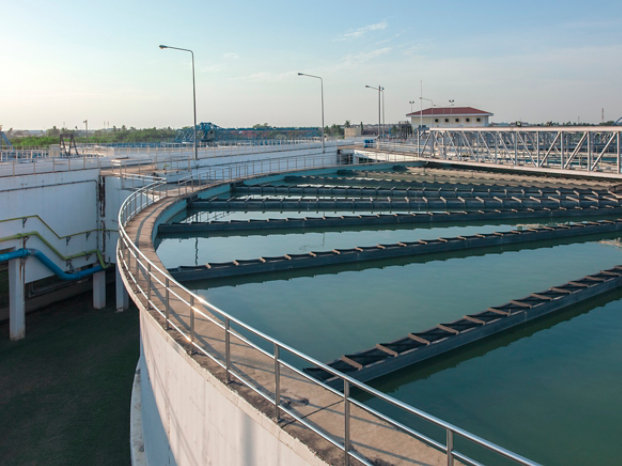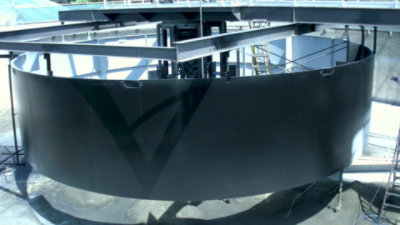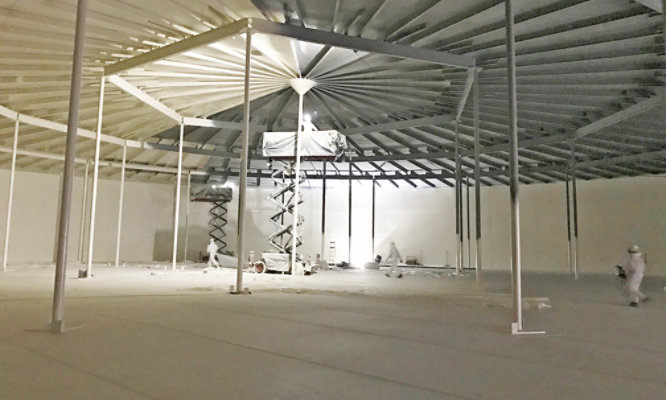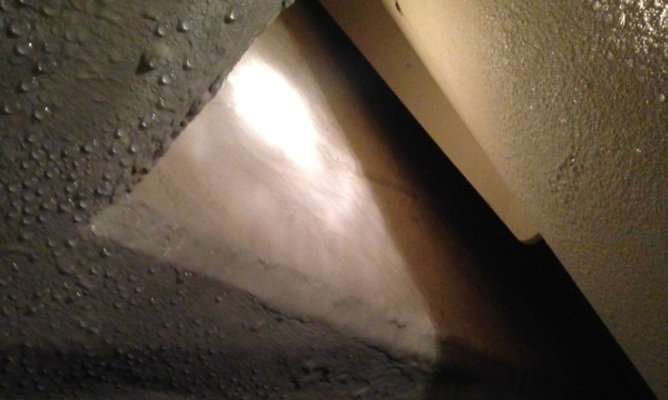
Water & Wastewater Concrete Surface Preparation Guide
Learn how to properly prepare a concrete substrate that is clean, sound, dry and free of surface contaminants.
INTRODUCTION
This concrete surface preparation guideline is provided as an aide to owners, design professionals, specifiers and contractors. All surfaces receiving an application of thin film, medium film, high-build linings, laminate or mortar systems must be structurally sound, clean and dry. Proper surface preparation is an extremely important factor in the immediate and longterm performance success of applied coating and lining systems.
The contractor responsible for the installation of the lining/coating system shall provide a substrate that is clean, sound, dry and free of surface contaminants. It is the responsibility of the lining/coating installer to ensure that the surface to be coated/lined is properly prepared prior to lining/coating application. Providing the “proper substrate” is the responsibility of the owner, the owner’s appointed representative and the concrete contractor, unless specifically stated otherwise. Regardless of responsibility, the steps listed below must be accomplished prior to the placement of a bonded polymer coating and lining system on concrete.
PROPER SURFACE PREPARATION
Proper surface preparation includes the following:
- Inspection of the concrete substrate
- Removal and replacement of non-durable concrete
- Decontamination of the concrete surface
- Creation of surface profile
- Repair of surface irregularities
1. Inspection of the concrete substrate is critical to determine its general condition, soundness, the presence of contaminants, presence of moisture vapor emissions and the best methods to use in preparation of the surface to meet the requirements of the owner or the owner’s appointed representative. A proper evaluation will lead to the selection of the proper tools and equipment to accomplish the objective.
2. Removal and replacement of non-durable concrete must be accomplished prior to installation of the polymer system. Localized weak or deteriorated concrete must be removed from sound concrete and replaced with the Sherwin-Williams or A.W. Cook cementitious or polymer concrete repair mortars. Large areas of concrete failure are best served by an engineered concrete mix design specified by the owner’s representative.
3. Decontamination of the concrete surface requires the removal of oils, grease, wax, fatty acids and other contaminants, and may be accomplished by the use of detergent scrubbing with a Sherwin-Williams cleaner and degreaser, low-pressure water cleaning (less than 5,000 psi), steam cleaning or chemical cleaning. Rinse thoroughly to achieve a final minimum surface pH of 10 or greater. Refer to ASTM D4262. The success of these decontamination methods are dependent upon the depth of penetration of the contaminant. In areas where the contaminants cannot be removed, the contaminated concrete must be removed and replaced as in #2 above. CAUTION: Decontamination methods that introduce large amounts of water may contribute to moisture related problems as referenced in Appendix A. Proper pH levels must be tested using pH meters, pH paper or pH pencils to ensure a final minimum surface pH of 10 or greater.
4. SSPC-SP13/NACE #6 Surface Preparation of Concrete Standards shall be used in conjunction with surface profile details provided in ICRI Technical Guideline No. 310.2R. Creation of surface profile can be accomplished by a number of methods, each utilizing a selection of tools, equipment and materials to accomplish the intended purpose (see Methods of Surface Preparation below). Selection is dependent upon the type of surface to be prepared and the type of system to be installed. In addition, floors, walls, ceilings, trenches, tanks and sumps each have their own requirements. The type and thickness of the selected polymer system also plays an important role in the selection process. Regardless of the method selected or tools employed, we must provide a surface that will accept the application of polymer-based products and allow the mechanical bond of the polymer securely to the concrete. The type of service to which the structure will be subjected will also help to define the degree of profile required. The surface profile is the measure of the average distance from the peaks of the surface to the valleys as seen through a cross sectional view of the surface of the concrete. This dimension is defined pictorially and through physical samples in the ICRI Technical Guideline No. 310.2R and is expressed as a Concrete Surface Profile number (CSP 1-9).
- For Sherwin-Williams Thin Film Linings up to 20 mils DFT, the surface profile shall be CSP 2 to 3, typically accomplished through decontamination of the concrete surface as defined in #3 above, followed by acid etching, grinding, light dry/wet abrasive blasting, light shot blast or water-jetting.
- For Sherwin-Williams Medium Film Linings up to 40 mils DFT, the surface profile shall be CSP 3 to 5, typically accomplished through decontamination of the concrete surface as defined in #3 above, followed by light dry/wet abrasive blasting, light to medium shot blast, light scarification or water-jetting.
- For Sherwin-Williams Laminate Linings and Self-Leveling Mortars, the surface profile shall be CSP 4 to 6, typically accomplished through decontamination of the concrete as defined in #3 above, followed by dry/wet abrasive blasting, light scarification, medium shot blast, medium scarification or water-jetting.
- For Sherwin-Williams Repair Mortars, Polymer Reinforced Mortars and Mortar Laminates, the surface profile shall be CSP 5 to 9. These are typically accomplished through decontamination of the concrete as defined in #3 above, followed by medium shot blast, medium scarification, heavy dry/wet abrasive blast, scabbled, heavy scarification or water-jetting.
- For Sherwin-Williams High Build Ultra High Solids Linings, whether direct to concrete or in conjunction with an outgassing reduction primer, the surface profile shall be CSP 3 to 5, typically accomplished through decontamination of the concrete surface as defined in #3 above, followed by light dry/wet abrasive blasting, light to medium shot blast, light scarification or water-jetting.
- After cementitious repair mortars have sufficiently cured, the surface shall be sweep blasted as per SSPC SP13/NACE #6 to create the recommended surface profile as listed above prior to the application of the coating/lining system. *The exception to this rule is when using Sherwin-Williams Dura-Plate® 2300 Cementitious Water-Based Epoxy Mortar. Dura-Plate 2300 does not require a sweep blast prior to application of primers or linings.
- For specific applications, always consult Sherwin-Williams Product Data Sheets and Installation Procedures or contact your local Sherwin-Williams Protective & Marine Representative.
5. Repair of surface irregularities, including bugholes, honeycombs, voids, exposed aggregate from chemical or biogenic sulfide attack, spalls, cracks, deteriorated joints, slopes and areas near transition zones, must be repaired prior to the placement of the polymer system. For treatment of cracks and joints, refer to the section below titled Crack Isolation. For additional questions, contact your local Sherwin-Williams Protective & Marine Representative.
When substantial deterioration of the concrete surface has occurred, fully or partially exposing the large aggregate of the concrete, the surface should be prepared and cleaned as per instructions above and fully parge coated with an appropriate mortar repair material. The repair material shall be selected based on the thickness of material required to return the surface to approximate original plane. Deep repairs may require successive lifts of materials capable of filling deep voids. A guide to material application thickness is as follows:
- Sherwin-Williams Dura-Plate® 2300 – feather edge up to ½” per lift
- A.W. Cook* Cemtec Thin Patch or TPM-TP – up to ½” per lift
- A.W. Cook Cemtec MSM (Microsilica Mortar) – ½” to 2” per lift
- A.W. Cook Rapid Grade Vertical – 1/8” to 2” per lift
- A. W. Cook Cementitious Repair Mortars are fully endorsed by Sherwin-Williams to be used under all Sherwin-Williams linings and coatings. All testing and applications of A.W. Cook Repair Mortars have been fully vetted and tested as compatible with Sherwin-Williams products. No substitutions will be allowed unless expressly indicated in writing by an approved Sherwin-Williams Technical Representative.
METHODS OF SURFACE PREPARATION
As per SSPC-SP13/NACE #6 and ICRI Guideline 310.2R, depending upon the condition of the concrete, one or more methods of surface preparation may be required. It is common for decontamination to precede mechanical preparation, and if necessary, a second decontamination to follow.
The preferred methods for creating a surface profile, including the removal of dirt, dust, laitance and curing compounds is steel shot blasting, abrasive (sand) blasting or scarifying. The steel shot blasting or vacuum blasting process is commonly referenced by equipment brand names, such as Blastrac, Vacu-Blast, Shot-Blast, etc. Vertical and overhead surfaces, such as cove base, wall and ceiling surfaces shall be prepared utilizing methods of grinding, scarifying, abrasive (sand) blasting, needle scaling, high-pressure water-jetting (5,000 to 45,000 psi) or vertical steel shot blasting. CAUTION: The use of highpressure water-jetting will introduce large amounts of water, which may contribute to moisture related problems as referenced in Appendix A.
Surfaces to receive the bonded polymer system must be inspected after the surface is prepared to ensure that the substrate is sound and structurally durable. Areas found to be unsound or non-durable must be removed and replaced as described in #2 above. Dust or other deleterious substances not removed after the initial surface preparation must be vacuumed, leaving the surface dust free and clean.
Other surface preparation methods are referred to in Additional Surface Preparation References at the end of this section.
CRACK ISOLATION
The performance of flexible coating systems and epoxy linings, such as Sherwin-Williams Poly-Cote™ 115, Dura-Plate® 6100, Dura-Plate® 6000 and Dura-Plate® UHS, requires a relatively uniform dry film thickness to resist drying shrinkage and thermal movement of the concrete, while maintaining a seamless bridge or seal over the concrete. Therefore, it is critical that all mortar splatter, protrusions, ridges, penetrations or sharp projections in the surface of the concrete be ground smooth or otherwise made smooth in addition to the normal surface preparation outlined above.
Prior to application of a flexible coating system or an epoxy lining material, control/contraction joints, construction joints and cracks should be filled with the appropriate specified cementitious repair mortar. Static surface cracks shall be v-grooved and fully vacuum cleaned prior to repairing with mortar. The entire surface area should then receive the specified lining/coating system complete with surface preparation.
EXPANSION/ISOLATION & ACTIVE MOVING CRACKS
When the lining material is an epoxy material, the isolation and/or expansion joints and potentially active cracks shall be honored through the system and final sealed using a polysulfide sealant material. When the lining material is a flexible material, the isolation and/or expansion joints and potentially active cracks shall be prepared and primed with the specified system primer. Potentially active cracks shall be v-grooved and vacuum cleaned. After the primer has sufficiently cured, the joint shall be filled and struck flush or slightly concave with a polysulfide or polyurethane joint sealant. Once the joint sealant material has sufficiently cured/dried, apply a 4-6” bond breaker material, centering the tape along the joint/crack. The flexible lining material can then be applied in a monolithic manner on all surfaces, including coating the bond breaker tape.
ADDITIONAL REINFORCEMENT
Additional strength reinforcement can be obtained over cracks and joints by embedding a 4.5 oz fiberglass detail scrim into the lining material. The scrim must be fully wetted and have enough lining material as a topcoat to fully bury the scrim profile.
Always follow details in accordance with the plans and specifications of an architectural or engineering design professional for the type of structure being considered.
INSTALLATION OF TRANSITION COVES
45° cant or 1” radius transition coves are required at all 90° wall to wall, floor to wall and pipe penetration transitions for all immersion linings. The cove detail can be built using one of the Sherwin-Williams approved repair mortars or Sherwin-Williams Steel-Seam™ FT 910 100% Solids Epoxy Filling and repair compound.
TERMINATIONS
High Build 100% Solids Epoxy or Elastomeric Polyurethane lining systems shall be terminated into a minimum ¼’ x ¼” saw cut whenever termination of the system occurs. This includes partially coated walls, around fixed brackets and other stationary components that cannot be removed for application. It is recommended that after lining installation is complete and sufficient dry/curing of the lining material is achieved that the termination detail be finished with a bead of polysulfide sealant as a final measure of protection.
Discover More
Industry Expertise and Innovation
See how we help customers find customized solutions for their project and application challenges.
Our Water & Wastewater Expertise
Explore our industry solutions and technology to help protect your assets.
LEARN MOREProduct Lookup
Find out more about our innovative coatings for a variety of industries.
FIND A PRODUCT

